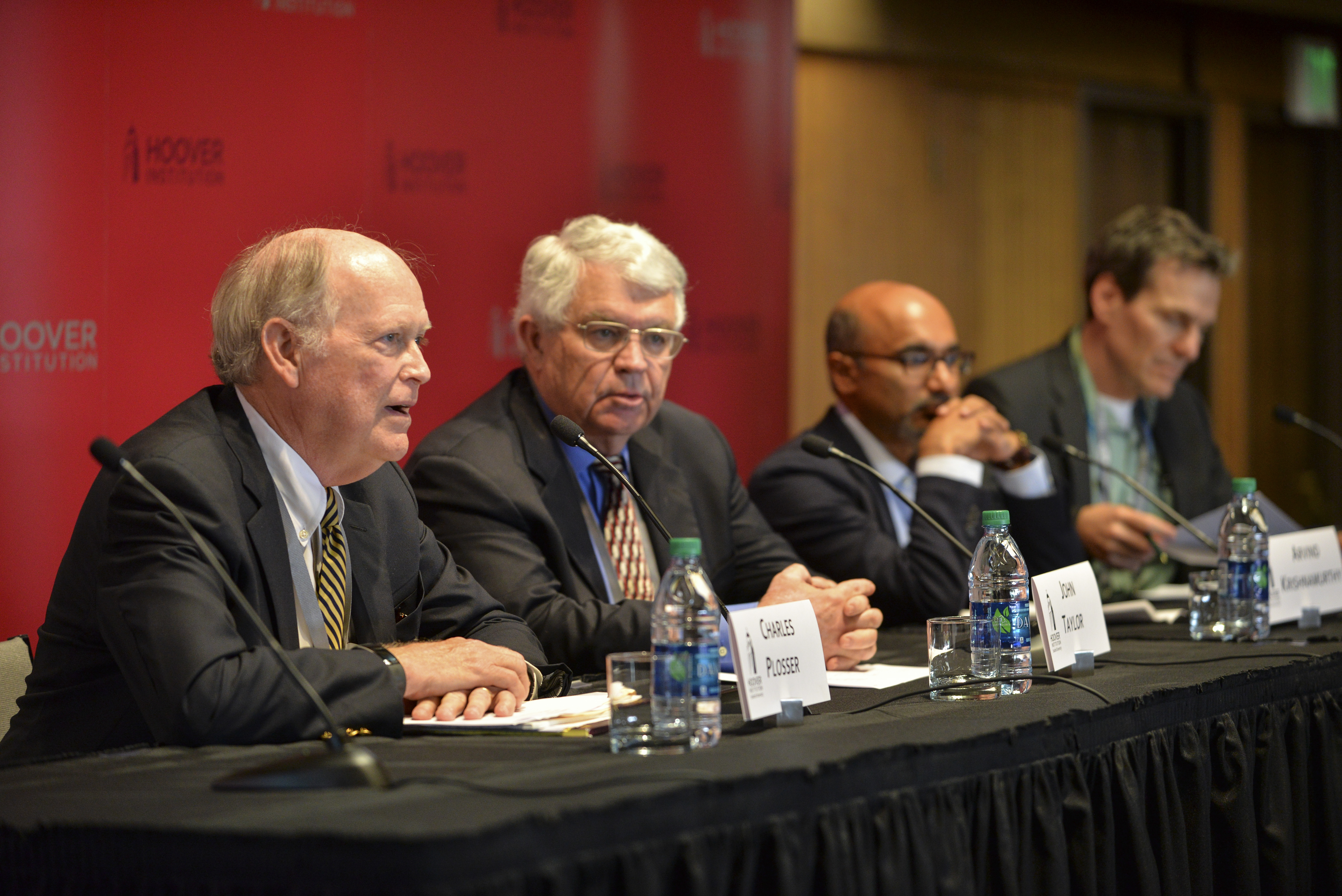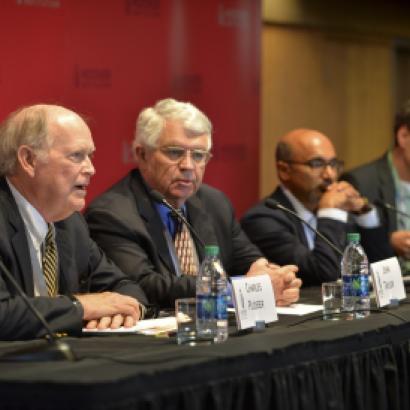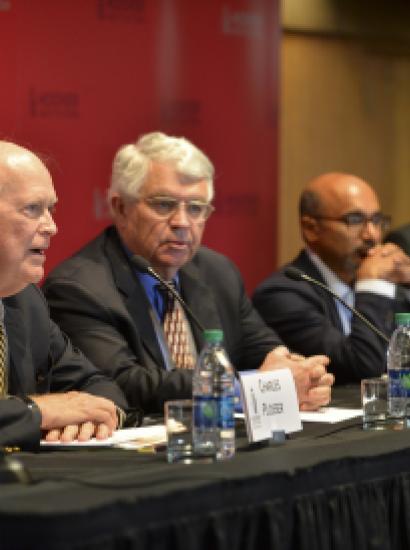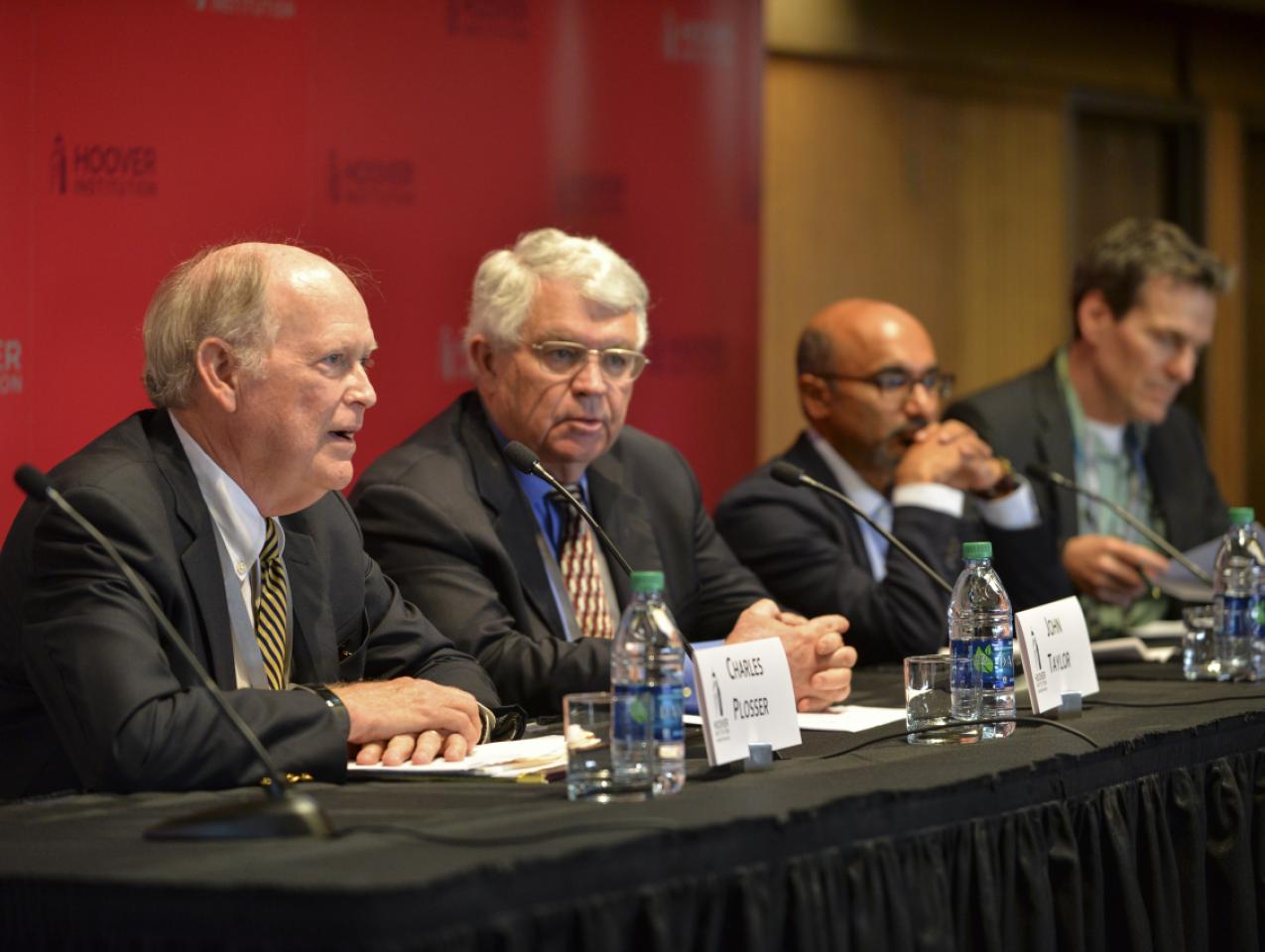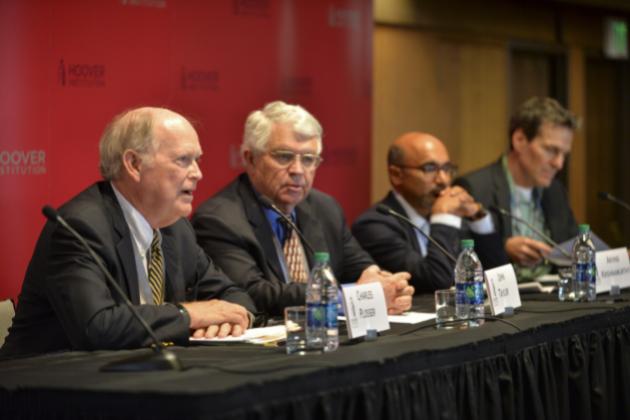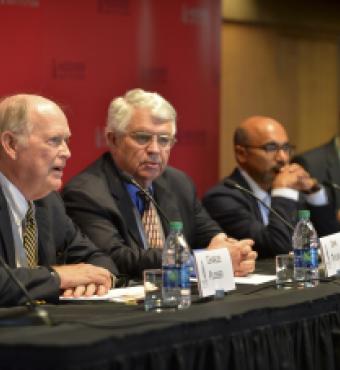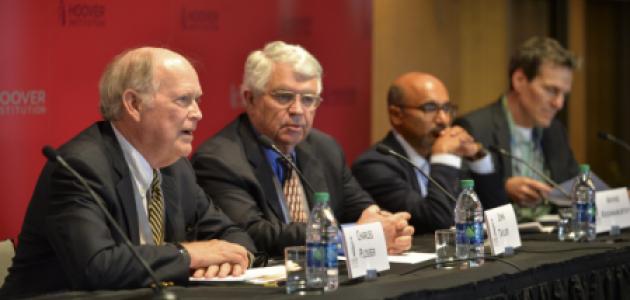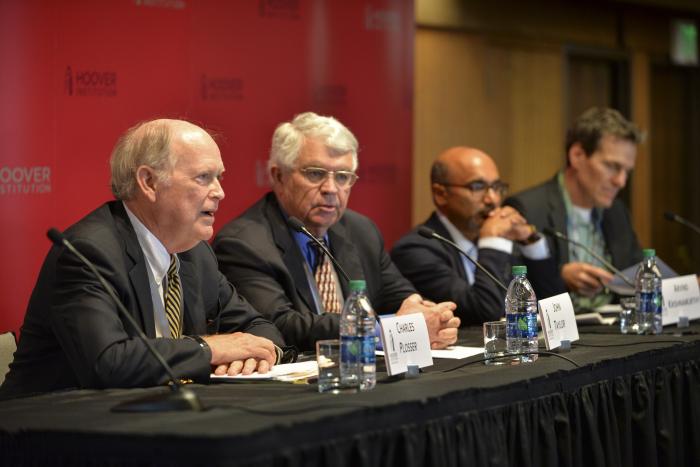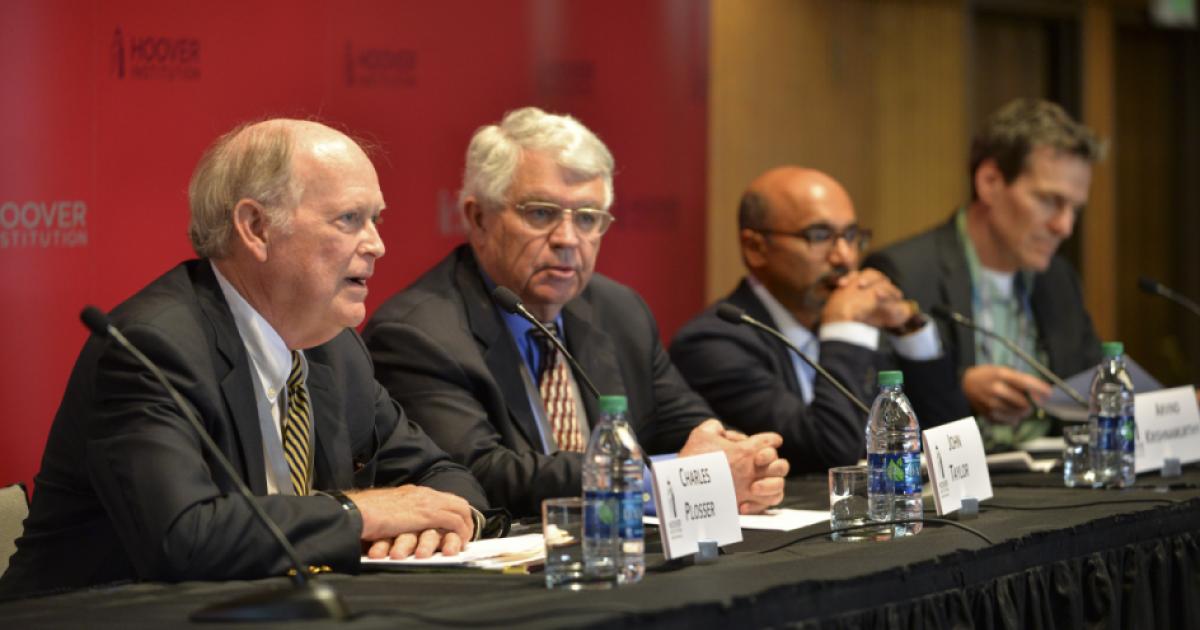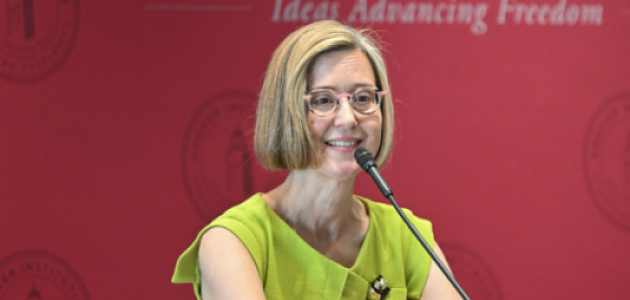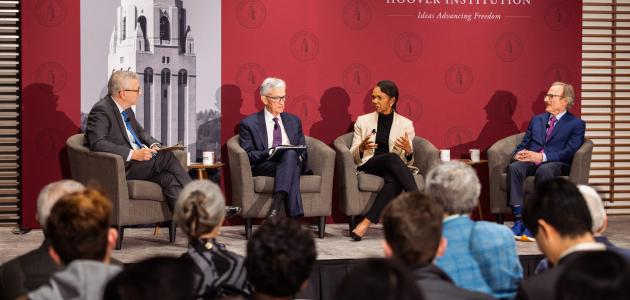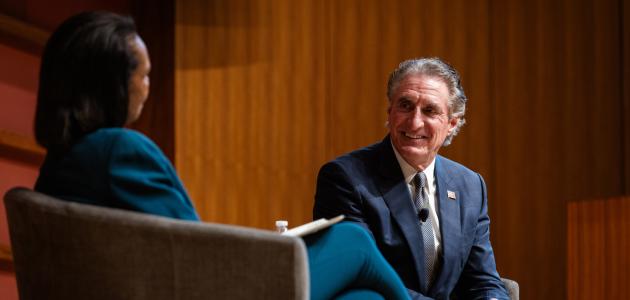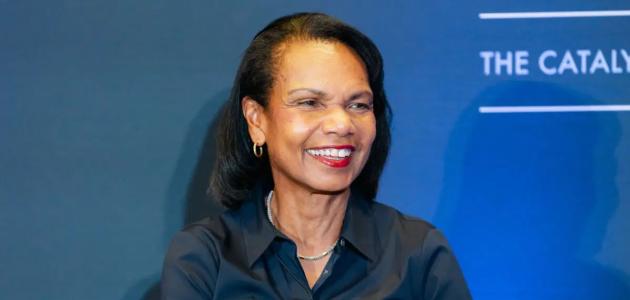Every year the Hoover Institution gathers leading academics, central bank authorities, and financial experts to explore new research and developments in monetary policy. Presenters, who reflect widely varying and often disparate views, share and critique research projects. Moderators bring other perspectives to light by encouraging in-depth discussion periods following each presentation. The direct, big-picture conversations that result are rare in academic conferences, earning the event a strong audience among economics reporters, central bankers, and the financial community.
Bringing a wide range of views together to address challenging post–great recession monetary policy issues is precisely what senior Hoover economists, including senior fellow and Stanford economics professor John Taylor, aimed for in launching the conference in 2014 to coincide with the Federal Reserve centennial. “Some of us, including Lee Ohanian, Mike Bordo, and John Cochrane, thought maybe there was not quite as much difference of opinion at the Fed centennial conferences as there could be,” Taylor explained, discussing the origins of the program at this year’s event, “so we said we’ll have our own conference.”
“In what was a surprise to us,” he continued, “it turned out to be quite popular.”
This year’s conference, the fourth of its kind, was titled “The Structural Foundations of Monetary Policy” and addressed several of the biggest challenges confronting central bankers and economists: monetary policy at the zero lower bound, the apparent downward shift in the neutral rate of interest (“r-star”), price stability in the face of a massive Fed balance sheet and zero interest-rate policy, Federal Reserve regulatory authority, and the advent of digital payment systems.
Exploring New Ideas in Monetary Policy
The first panel of the conference covered the dramatically expanded post-quantitative- easing Federal Reserve balance sheet. Panelist Charles Plosser, former president of the Federal Reserve Bank of Philadelphia and a visiting fellow at Hoover, warned about the hazardous incentives a large balance sheet creates to engage in fiscal policy. Co-panelist John Taylor (paper) called for the Fed to speed up its balance-sheet normalization to restore supply and demand, rather than interest payments on excess reserves, as the driver of interest rates. Arvind Krishnamurthy (paper) of Stanford’s Graduate School of Business made a counterpoint that the benefits of a large balance sheet in reducing short-term bank volatility outweigh Plosser and Taylor’s concerns about incentives and discretionary policy.
Volker Wieland (paper one and paper two) of Goethe University and the Institute of Monetary and Financial Stability explained complications in measuring r-star—the “natural” short-term interest rate in a neutral policy environment—and the resulting difficulties in using it as a guide for monetary policy. Lee Ohanian, senior fellow at Hoover and professor of economics at UCLA, critiqued other assumptions underlying policy makers’ attention to r-star, pointing out, for instance, the lack of a “Philips Curve” relationship that central bankers can use to affect employment through inflation. He argued that, whatever the rate of r-star, structural improvements to capital markets, rather than interest-rate policy, are the right prescription for economic growth.
Senior Fellow John Cochrane (read paper) argued that both monetarist and new Keynesian models fail to explain the price stability that has followed quantitative easing and zero-interest-rate policy, and discussed a fiscal policy-influenced price level as an alternative explanation. Martin Eichenbaum rebutted the assumptions behind Cochrane’s critique of new Keynesian models and discussed the benefits of fiscal policy as an accommodative tool when monetary policy is stuck at the zero lower bound.
In a panel on central bank payment systems, Laurie Simon Hodrick, visiting fellow at Hoover and professor of economics at Columbia Business School, discussed blockchain-based distributed ledger technology as an efficient, secure, and transparent alternative to central bank–administered double entry bookkeeping. Jesús Fernández-Villaverde (read paper), professor of economics at the University of Pennsylvania and a former Hoover national fellow, discussed cryptocurrencies such as Bitcoin and Ethereum as money alternatives comparable to private, competing currency systems advocated by, for example, Friedrich Hayek. Hoover distinguished visiting fellow Michael Bordo and Dartmouth economics professor Andrew Levin (read paper) discussed the serious consideration central banks are giving to digital currency systems, which Bordo and Levin argue are both viable and a potential source of greater price stability and central bank transparency.
Princeton economics professor Markus Brunnermeir discussed a “Rhine divide” between the economic policies of France and Germany to illustrate the power of ideology in driving states with congruent economic interests toward fundamentally different policies. Hoover distinguished visiting fellow Kevin Warsh (read speech) warned that being prepared for the next economic crisis requires the Fed to reevaluate what he sees as an overly complacent climate of ideas. “The most common forecasting error is groupthink,” said Warsh. “The best forecasting fix,” he continued, “is among us: a humble, independent, diverse, intellectually rigorous, and cohesive group who are not satisfied with the status quo.”
Policy Makers Join the Discussion
The second day of the conference focused on bringing Federal Reserve authorities into the conversation, beginning with Federal Reserve System vice chair Stanley Fischer. Fischer (watch video or read speech) reacted to calls for stricter adherence to monetary rules, which he argued tie the hands of monetary policy committees as they work to aggregate and respond to complex economic information.
Distinguished Fellow George P. Shultz introduced the final panel (watch video), which featured John Cochrane in conversation with three Federal Reserve Bank presidents: James Bullard (St. Louis), Charles Evans (Chicago), and Eric Rosengren (Boston). The panelists’ perspectives complemented earlier discussions and offered a glimpse inside current opinion within the Fed. Highlights from the panel included a discussion of the future of the Fed balance sheet, which Charles Evans predicted will definitely shrink from its current value of more than $4 trillion but, due to changed economic fundamentals, not to pre–great recession levels. Jim Bullard called for the Fed to create room for future quantitative easing on the balance sheet, as it has recently done with interest rates. Eric Rosengren explained that the current 3 percent target federal-funds rate could not accommodate a typical 5 percent rate reduction during a recession, so the balance sheet will have to remain an alternative tool for accommodative policy.
The panel also discussed the unexpectedly “quiet” period of economic stability that has accompanied monetary policy at the zero lower bound. Rosengren cautioned that inflation and employment measures are always subject to change, and that policy makers need to be ready to react freely without the constraints of strict policy rules. Bullard described the lack of inflation in the current interest rate climate as a “shocking development from the point of view of received economic theory,” and Evans praised the St. Louis Fed under Bullard for helping ward off potential groupthink by developing novel explanations for this apparent monetary paradox.
John Cochrane also brought up calls for reform of Fed oversight and authority, embodied most recently in the Financial Choice Act, which passed through the House Financial Services Committee the day before the panel. Rosengren argued the Fed’s supervisory authorities are crucial tools for maintaining economic stability and shouldn’t be rolled back. Bullard focused on reforming Fed communications, calling for more frequent reporting and fewer large dumps of potentially surprising information. Evans talked about the importance of accountability in balancing central bank independence with democratic norms and touched on the Fed “dot plot” as a valuable index of differences of opinion within the Fed.
Media Coverage
Business and economics reporters have increasingly covered the conference as an important annual window into high-level discussions at the intersection of monetary policy and research. Reporters attended from the New York Times, Wall Street Journal, Reuters, CNBC, and the Los Angeles Times. Michael McKee of Bloomberg filmed interviews with Kevin Warsh and John Taylor. An Investor’s Business Daily editorial discussed Jesús Fernández-Villaverde’s presentation on cryptocurrency, and the Financial Times ran an article on the Fed balance sheet based on presentations and interviews at the conference. The event live streamed at Hoover.org, and the Federal Reserve and Chicago Fed Twitter accounts both linked to the video feed.
The Benefits of Diverse and Open Discussion
Conferences for academics, policy makers, and media are a staple of Hoover scholarship, and this annual conference highlights the important voice that Hoover earns in policy-making discussions as a result. The conference series also illustrates a core Hoover value: sound policy is best advanced through open, big-picture discussions that welcome diversity of opinion.
Reflecting on the event, John Cochrane cited Stan Fischer’s presentation as an example of the frank tone and intellectual integrity that sets this conference apart from others. “Fisher came right to the home of John Taylor to say he thought rules were a bad idea,” said Cochrane, “and that the wisdom of the committee with little pre-commitment would save the day.”
“It is not common for policy makers to be forced to think hard about just how and why a large balance sheet might be a good or bad thing, for example,” Cochrane continued. “Conversely, it helps academics tremendously to hear how policy makers perceive things, how they think about things, and what issues are on their mind. I think we get better research and better and better thought-out policy from it.”
Despite the progress made during each of these annual conferences, no one seems to see a grand consensus on the horizon. John Taylor laughed about this persistent diversity of opinion during remarks over dinner. “I have specific views on all these topics,” said Taylor, referring to his preferences for rules-based policy, supply- and demand-determined interest rates, and other prescriptions for challenges discussed at the conference. “Unfortunately,” he joked, “I haven’t convinced everybody.”
“There are lots of views out there,” Taylor continued, “and of course we have to cover them.”







